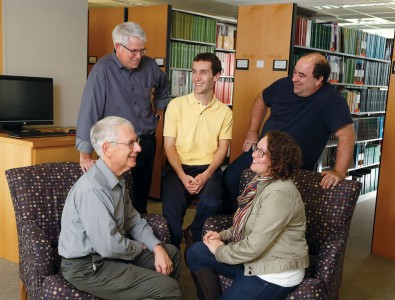Team Players
With the creation of new majors and degrees to meet the shifting demands of today’s incoming students, as well as the continued enrichment of The OWU Connection, our faculty continually demonstrate their forward-thinking academic creativity and curiosity.

In the new team-taught Introduction to Data Analytics course, five professors from five different departments apply five different perspectives to give one well-rounded introduction to the subject matter.
“We wanted to give students a sense of the breadth of the field, the way that data analytics manifests itself in multiple disciplines,” says Ashley Noelle Biser, associate professor of politics and government.
Or, as mathematics and computer science associate professor Sean McCulloch explained, the class offers “a survey of all the different things you can do with data analytics, which is using vast amounts of data to solve problems in your specific field.”
In addition to Biser and McCulloch, Bob Gitter is handling the economic implications; Scott Linder is tackling mathematics and computer science; and Christian G. Fink, assistant professor of physics, astronomy and neuroscience, is approaching the subject through his field’s lens. The five instructors were also involved in the creation of the data analytics major, which is new this year.
Dale Brugh, associate dean for innovation and technology, worked with them to conceptualize the idea and help determine whether the university should and could offer it. “The use of data is becoming more and more important to our society,” Brugh says. “There’s a need for students to understand how to process the data and make decisions based on data.”
Brugh felt that, as a liberal arts university, Ohio Wesleyan could offer students an aspect of the major that larger institutions might not: an understanding of the cultural, social and ethical impact of using data. “We want to produce graduates who start asking questions about where the data came from, is it free of bias, should it be used to make certain decisions,” he says.
That’s where the five professors from across campus come in.
(Team-teaching) gives students the chance to study the same issue from different perspectives, and that’s invaluable.
professor of economics
In her lectures for the class, Biser addresses the social, ethical, and political questions surrounding data, its collection and how it is used. “I’m trained as a political theorist, and I was brought into this because I think a lot about the implications of technological progress,” she says. “I’m working with students on the choices that are made in the collection of the data, in terms of areas like privacy and confidentiality. And then, what are the ethical and political implications of how that data is used?”
McCulloch gives students the nuts-and-bolts: basic background in how databases work, then some simple computer programing that could be used in data analytics.
Gitter is showing students how to use software programs such as Microsoft Excel to conduct data analytics as well as how to analyze survey data.
“How could you use government-survey data about households to examine childhood poverty, for example?” he says. Later in the class, he’ll show students how data can be misused.
“If you’re constructing data analytics, what’s your responsibility? That’s what I want the students to wrestle with: how to use data analytics for good and not for evil.”
Sophomore Aidan Shumaker is taking the class to see whether he’d like to pair data analytics with microbiology and have a double major.
“I like the fact that we have five professors a lot,” says Shumaker, 19, of Loveland, Ohio. “Each one is teaching a different side of data analytics, and you get different viewpoints.” He says the weekly rotation of professors keeps the class interesting and lively.
Sophomore Austin Moore hasn’t decided on a major but took the class because it counts as a science requirement for graduation and he’s interested in how data can be used in society.
“We’re being taught skills useful in the real world,” says Moore, 18, of Los Angeles. “By having five professors, we’re given a well-rounded background in the subject.”
Moore would like to see more computer programming included in future years for the class, but expects such tweaks will come with time. “For the first time it’s been taught, they’re doing a good job of giving us a diverse experience,” Moore says.
Organizing what will be taught in the class and when it will be taught has been time-consuming. “I teach one-fifth of the classes, but it’s more work than teaching one-fifth of a normal class,” Gitter says.
While team-teaching is not new to campus, the intro class is the first with five professors that anyone can recall at OWU.
McCulloch says communication has been key. “We all want to be on the same page, and that’s taken a lot of work before the class started,” he says.
As the University strives to encourage such faculty innovation through the Connect Today, Create Tomorrow campaign – with $12 million designated for that purpose – such an approach could become more common.
“If this is successful,” McCulloch says, “I might put out a call to other departments to see if they’re interested in similar classes.”
Gitter hopes that happens; he already has some ideas about classes he’d like to team-teach with professors in other majors. “It gives students the chance to study the same issue from different perspectives, and that’s invaluable,” he says. “No one department or field has all the answers, and that’s the beauty of a liberal arts education.”
